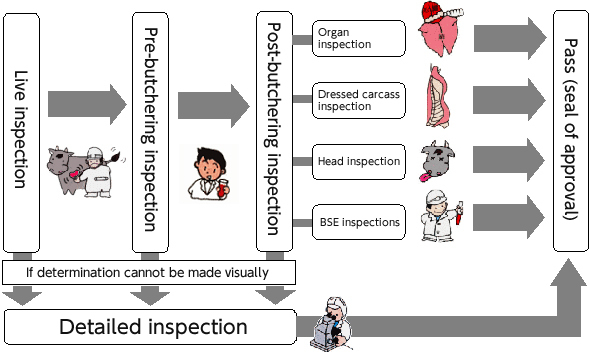Tokyo Food Safety Information Center » Good things to know » Meat inspection
Meat inspection
What are slaughter inspections?
The process which ensures the safety of your meat from start to finish
Today, we can find a variety of foods for sale at their local supermarket. Unlike most other foods, however, special inspection systems have been established for meats like beef and pork.
These systems ensure that each animal is officially inspected and that only meat which has passed inspection is released for sale. Meat which has not passed inspection may not be sold.What are the requirements for using livestock like pigs and cattle for food?
The Slaughterhouse Act established the requirements which must be followed in order to use livestock such as cattle, pigs, horses, sheep, and goats as food, including:
- Butchering conducted at a slaughterhouse
- Inspection to ensure there are no transmittable diseases
- Only animals which have passed inspection
may be used for food.
What is inspected?
The inspection to identify the presence of any disease is called the slaughter inspection. Slaughter inspections are conducted by Slaughter Inspectors who are employed by the prefectures (which contain cities establishing health centers) and who are licensed as veterinarians.
In Tokyo, there are three slaughterhouses, including two on islands. The slaughter inspections are conducted by Slaughter Inspectors at the Shibaura Meat Sanitary Inspection Station. In addition to disease inspections, meat is also checked to make sure no antibiotics or other substances remain at the Meat Sanitary Inspection Station.
Slaughter inspection process

Slaughter inspection details
Each animal undergoes inspection.
Inspections are mainly conducted visually, but in the event a determination is difficult to make, other, more precise inspection methods are used to make a comprehensive judgement, including microbiological, physical, chemical, and pathological inspection methods. |
(1) | Live inspection | The animal is inspected while alive to check for any disease. The slaughter of animals infected with a disease which can be transmitted to other livestock is prohibited. |
 |
(2) | Pre-butchering inspection | Focusing on a blood test, butchering is prohibited if any abnormalities are found. |
 |
(3) | Post-butchering inspection | After butchering, the following three inspections are conducted. If any systematic diseases are found, the entire body is disposed of, including meat, organs, and hide. |
| A. Head inspection The muscles, lymph nodes, tonsils, and tongue are inspected. |
|||
 |
B. Organ inspection Organs such as the heart, lungs, liver, and stomach are inspected. The lymph nodes are also removed and thoroughly checked. |
||
| C. Dressed carcass inspection This is the last inspection conducted. The meat, fat, bones, joints, and lymph nodes are inspected, and the state of the carcass as a whole, as whether water can flush well through the carcass, is also checked. |
|||
| In the even any portion is discovered to be unsuitable for human consumption at any stage of inspection, that portion is disposed of. |
Accordingly, only meat which has passed numerous stages of strict inspection receives a seal of approval and may be sold commercially.